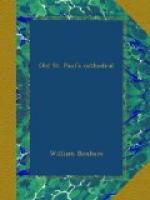and another warm friend made now was Sir Thomas More,
who earnestly helped him in his strenuous endeavours
to improve the cathedral statutes, to reform abuses,
and to increase the preaching power. He was a
rich man, and in 1509 he employed much of his wealth—about
L40,000 present value—in the foundation
of St. Paul’s School. He wrote some simple
precepts for the guidance of masters and scholars,
and drew up prayers and an English version of the Creed.
He appointed William Lilly first master, and called
on Linacre to write a Latin grammar. The school
became famous; it was burnt down in the Fire, rebuilt
in 1670, and removed to Hammersmith in 1884. It
is not to be wondered at that many of the churchmen
of the day regarded Colet as a most dangerous innovator.
Complaints were made to Archbishop Warham that he
was favouring the Lollards, which was absolutely untrue.
He would in all probability, had he lived, have been
found on the same side as More and Fisher, that is,
intensely desirous to preserve the Church and its
doctrines, but to cleanse it from the foul scandals,
the sloth, greed, immorality, which were patent to
all the world. There was a meeting of Convocation
in February, 1512, to consider how to extirpate the
Lollard heresy which was reviving. Warham appointed
Colet to preach the sermon, which he did with wonderful
energy, denouncing the simony, the self-indulgence,
and the ignorance of the bishops and clergy.
The Lollards were there in great numbers, attentive,
silent listeners. He was as plain and honest with
the King himself, who, recognising his goodness of
purpose, made him a Royal Chaplain. In 1514,
he went with Erasmus on pilgrimage to Becket’s
tomb and ridiculed the accounts which the vergers gave
of the healing power of the relics. When Wolsey
was installed as Cardinal, Colet preached, and warned
him against worldly ambition. And all through
his time at St. Paul’s the aged Bishop Fitzhugh
was in active hostility to him. He died September
16th, 1519, and, although he had requested that only
his name should be inscribed on his grave, the Mercers’
Company erected a handsome tomb, for which Lilly wrote
a long inscription. Lilly and Linacre were both
buried near him.
It will be seen, I think, at once that Colet is a great representative of the thoughtful and earnest men of his time, one of the greatest precursors of the Reformers, or rather, in full sense, a great reformer himself. We have now to take up the course of secular events. In 1514, Pope Leo X. sent young King Henry VIII. a “sword and cap of maintenance” as a special honour, and he, “in robe of purple, satin, and gold in chequer, and jewelled collar,” came to the Bishop’s palace, and from thence there was a grand procession of gorgeously-arrayed nobles and clerics round the church, with joyous hymns.




